Væskecelletransmissionselektronmikroskopianalyse af halvledernanokrystaller
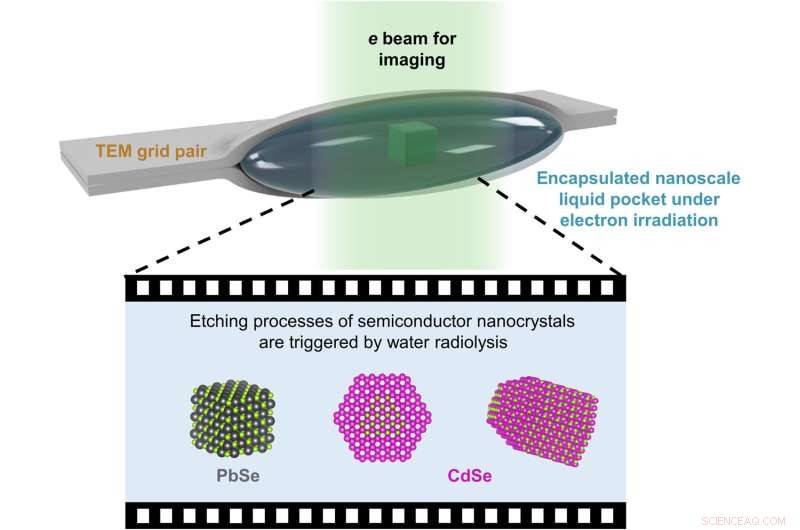
Illustration af LCTEM eksperimenterne. Tværsnitsbilledet viser, at et tyndt vandigt lag indeholdende halvledernanokrystaller er klemt mellem to ultratynde kulstoffilm af et par TEM-gitre. Elektronstrålen, der passerer gennem vandet og kulstoflagene, forårsager vandradiolysereaktioner, som derefter udløser ætsningsbanerne til at blive afbildet med LCTEM. Kredit:Science Advances (2022). DOI:10.1126/sciadv.abq1700
Halvleder nanokrystaller af forskellige størrelser og former kan styre materialernes optiske og elektriske egenskaber. Flydende celle transmission elektronmikroskopi (LCTEM) er en ny metode til at observere kemiske transformationer i nanoskala og informere den præcise syntese af nanostrukturer med forventede strukturelle træk. Forskere undersøger reaktionerne af halvledernanokrystaller med metoden til at studere det meget reaktive miljø, der produceres via flydende radiolyse under processen.
I en ny rapport, der nu er offentliggjort i Science Advances , Cheng Yan og et forskerhold i kemi og materialevidenskab ved University of California Berkeley og Leibniz Institute of Surface Engineering, Tyskland, udnyttede radiolyseprocessen til at erstatte enkeltpartikelætsningsbanen for prototypiske halvledernanomaterialer. Bly selenid nanorør, der blev brugt under arbejdet, repræsenterede en isotrop struktur for at bevare den kubiske form til ætsning gennem en lag-for-lag-mekanisme. De anisotrope pilformede cadmiumselenid nanorods opretholdt polære facetter med cadmium eller selen atomer. Banerne for transmission flydende celle elektronmikroskopi afslørede, hvordan reaktiviteten af specifikke facetter i flydende miljøer styrede nanoskala formtransformationer af halvledere.
Optimering af flydende celletransmissionselektronmikroskopi (LCTEM)
Halvleder nanokrystaller indeholder bredt afstembare optiske og elektriske egenskaber, der afhænger af deres størrelse og form til en bred vifte af applikationer. Materialeforskere har karakteriseret reaktiviteten af specifikke bulkkrystalfacetter mod vækst og ætsningsreaktioner for at udvikle de mest vilkårlige mønstre i top-down bulk-halvlederbehandling. De mange facetter af nanokrystaller og deres reaktionsmekanisme gør dem interessante til direkte undersøgelse. Termodynamikken af kolloide nanokrystaller kan påvirke de organisk-uorganiske grænseflader, der definerer dem. Flydende celle transmission elektronmikroskopi tilbyder den nødvendige rum-tid opløsning til at observere nanoskala dynamik, såsom selvsamlingsprocessen. Holdet anbragte derfor en vandig lomme indeholdende nanokrystaller mellem de ultratynde kulstoflag i to transmissionselektronmikroskopgitre og brugte tris (hydroxymethyl) aminomethanhydrochlorid (tris·HCl), et organisk molekyle til at regulere ætsningen af følsomme halvledernanokrystaller.
Eksisterende forskning om LCTEM og nanokrystaller er begrænset til ædelmetaller på grund af deres manglende evne til at regulere det kemiske miljø under radiolyse, hvilket får reaktive materialer til at nedbrydes. Nyere forskning tyder på en mulighed for at designe nye miljøer for LCTEM for at observere enkeltpartikelætsningsbaner af reaktive nanokrystaller. Under eksperimenterne regulerede tris·HCl-additivet det elektrokemiske potentiale af ætningsprocessen, og holdet brugte kinetisk modellering til at estimere koncentrationen og det elektrokemiske potentiale af aminradikalarten i den flydende celle.
Proof-of-concept
As proof of concept, the scientists obtained representative transmission electron microscopy images of a lead selenide nanocube in vacuum and gathered a time-series of images during layer-by-layer etching of lead selenide nanocrystals. The outcome of LCTEM imaging showed the formation of a substance with higher image contrast around the lead selenide nanocrystals as a product of etching reactions, it appears that during the etching process, selenium oxidized and dispersed into the liquid to facilitate the formation of lead chloride, with chloride ions in the lead pocket. When compared to the cubic lattice of lead selenide, wurzite cadmium selenide featured an anisotropic lattice with alternating layers of cadmium and selenium atoms. During the growth of wurzite cadmium selenide nanocrystals, the surfactant ligands favorably bound to the cadmium regions to facilitate the fast growth of selenium regions.
Yan et al. presented the structure of cadmium selenide nanorods resolved via high-angle annular dark field scanning transmission electron microscopy in vacuum. The scientists generated the images by collecting electrons scattered to high angles by atoms in the material to develop mass-thickness image contrast, where cadmium was brighter than selenium. The team similarly performed in situ etching experiments on arrow-shaped cadmium selenide nanorods.
-
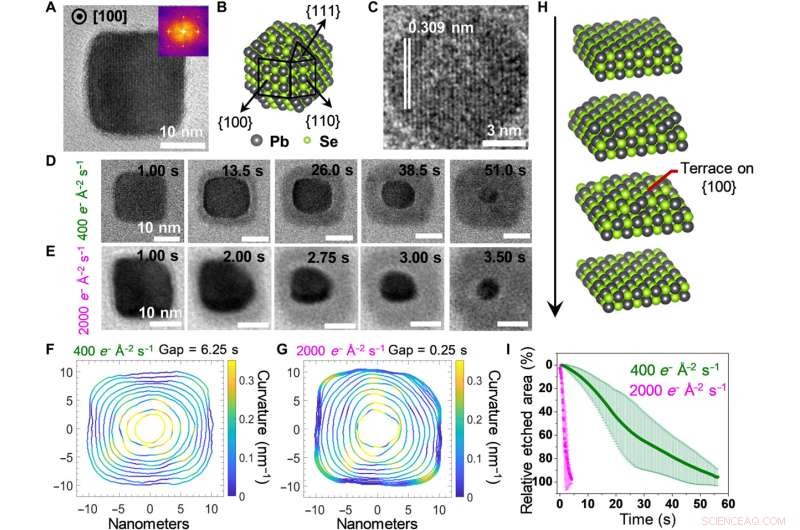
Structural characterization and etching trajectories of PbSe nanocubes. (A) Representative static TEM image of a PbSe nanocube oriented along the [100] zone axis. (B) Atomistic model of a truncated PbSe nanocube exposing different facets. (C) The LCTEM image captured near the end of an etching trajectory, exhibiting the characteristic d-spacing of {200} lattice planes of PbSe. (D and E) Time-lapse LCTEM images recorded at the electron fluence rates of 400 e− Å−2 s−1 (D) and 2000 e− Å−2 s−1 (E), respectively. (F and G) Outlines of the nanocrystals plotted with equal time gaps for illustrating the evolving shapes and local curvatures of PbSe nanocrystals recorded at 400 e− Å−2 s−1 (F) and 2000 e− Å−2 s−1 (G), respectively. (H) Scheme of the layer-by-layer etching mechanism, which proceeds via terrace intermediates. (I) The time-dependent plots of the relative etched area normalized to the projected area of the PbSe nanocube at the starting frame. Kredit:Science Advances (2022). DOI:10.1126/sciadv.abq1700
-
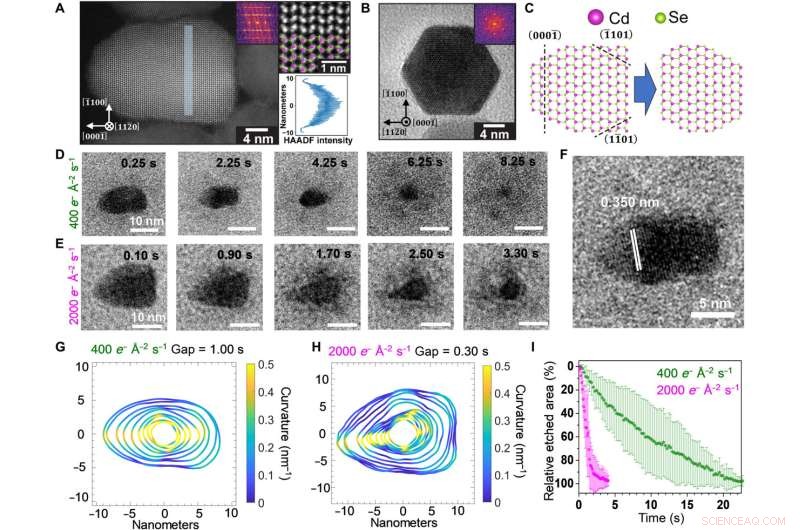
Structural characterization and etching trajectories of CdSe nanorods. (A) AC-HAADF-STEM image of a wurtzite CdSe nanorod projected along the [110] zone axis (left). The enlarged inset (top right) verifies the polarity of the nanorod:The tip of the rod is terminated by Se (green), while the bottom is terminated by Cd (pink). The line profile of HAADF-STEM intensity in the shaded segment (left) projected along the [00] axis is included in the bottom right. (B) TEM image of a nanorod oriented along the c axis showing a hexagonal projection. (C) Lattice models of a CdSe nanorod projected along the [110] axis (left) and the truncated structure (right) formed by selectively etching the Se-terminated facets. (D and E) Time-lapse LCTEM images recorded at electron fluence rates of 400 e− Å−2 s−1 (D) and 2000 e− Å−2 s−1 (E), respectively. (F) The LCTEM image exhibiting the characteristic d-spacing of {0002} lattice planes. (G and H) Outlines of the nanocrystals plotted with equal time gaps for illustrating the evolving shapes and local curvatures of CdSe nanorods at 400 e− Å−2 s−1 (G) and 2000 e− Å−2 s−1 (H), respectively. (I) Time-dependent plots of the relative etched area normalized to the projected area of the CdSe nanorod at the starting frame. Kredit:Science Advances (2022). DOI:10.1126/sciadv.abq1700
The etching trajectory of a wurtzite CdSe nanocrystal viewed along the [000] axis. (A) Time-lapse LCTEM images recorded at 400 e− Å−2 s−1. (B) Atomistic model of the CdSe nanocrystal with the (000) facet pointing up. (C) Time-dependent plot of the average electron fluence rates detected in different color-coded segments (inset) of the LCTEM images. Gray color corresponds to the background region surrounding the nanocrystal. (D) 3D illustration of the etching process showing that the selective etching of the Se-terminated (000) facet causes the tip to transform into a concave pit in the nanocrystal. Kredit:Science Advances (2022). DOI:10.1126/sciadv.abq1700
In this way, Cheng Yan and colleagues used liquid cell electron microscopy (LCTEM) to show the possibility of directly examining the facet-dependent reactivity of colloidal nanocrystals at the nanoscale. The method offered real-time, continuous structural trajectories, in contrast to classical methods. Existing research had already highlighted the effect of the inclusion or removal of ligands on the self-assembly and etching of nanocrystals in LCTEM experiments.
The team showed how sensitive nanomaterials such as lead selenide can be studied using LCTEM and highlighted the inclusion of organic additives such as tris·HCl to regulate the radiolytic redox environment in liquid cell electron microscopy. Future studies can enable the potential to gain real-time information about the transformation of an array of functional nanostructures with increasing complexity using core/shell nanocrystals, as well as those assembled via inorganic-organic interfaces. + Udforsk yderligere
How gas nanobubbles accelerate solid-liquid-gas reactions
© 2022 Science X Network
 Varme artikler
Varme artikler
-
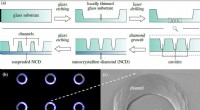 Diamanter er for evigt:Nyt fundament for nanostrukturerDette tal fremgår af forskernes undersøgelse, udgivet i Diamond and Related Materials. (a) Skemaer af tværsnittet af et fundament før og efter trin i fremstillingsprocessen. (b) Optisk mikrograf af mø
Diamanter er for evigt:Nyt fundament for nanostrukturerDette tal fremgår af forskernes undersøgelse, udgivet i Diamond and Related Materials. (a) Skemaer af tværsnittet af et fundament før og efter trin i fremstillingsprocessen. (b) Optisk mikrograf af mø -
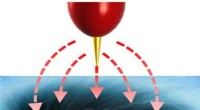 Tæmme vilde elektroner i grafenEn skarp spids skaber et kraftfelt, der kan fange elektroner i grafen eller ændre deres baner, svarende til den effekt en linse har på lysstråler. Kredit:Yuhang Jiang/Rutgers University-New Brunswick
Tæmme vilde elektroner i grafenEn skarp spids skaber et kraftfelt, der kan fange elektroner i grafen eller ændre deres baner, svarende til den effekt en linse har på lysstråler. Kredit:Yuhang Jiang/Rutgers University-New Brunswick -
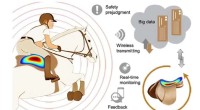 Smart sadel kunne hjælpe ryttere med at nå deres skridtDygtige ryttere får avancerede ridemanøvrer, såsom hop, spins og piaffer, til at se ubesværede ud. Men god ridning kræver balance og subtile signaler til hesten, hvoraf mange gives gennem rytterens kr
Smart sadel kunne hjælpe ryttere med at nå deres skridtDygtige ryttere får avancerede ridemanøvrer, såsom hop, spins og piaffer, til at se ubesværede ud. Men god ridning kræver balance og subtile signaler til hesten, hvoraf mange gives gennem rytterens kr -
 Ny undersøgelse er et skridt i retning af at skabe fly, der rejser med hypersonisk hastighedBinghamton University lektor i maskinteknik Changhong Ke. Kredit:Binghamton University, State University of New York En gennemsnitlig flyvning fra Miami til Seattle tager omkring seks timer og 40
Ny undersøgelse er et skridt i retning af at skabe fly, der rejser med hypersonisk hastighedBinghamton University lektor i maskinteknik Changhong Ke. Kredit:Binghamton University, State University of New York En gennemsnitlig flyvning fra Miami til Seattle tager omkring seks timer og 40
- Jagt på giftige stoffer i slam
- Tritium introduceret i fusionsforsøg på Sandia
- Manglende rapportering om fosforforsyningskæden er farlig for den globale fødevaresikkerhed
- Varme elektroner høstet uden tricks
- Troende maskiner kan udtrænge mennesker kan brænde accept af selvkørende biler
- Hvorfor det bliver superkoldt inde i en tornado,


